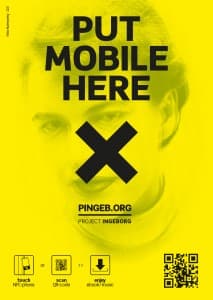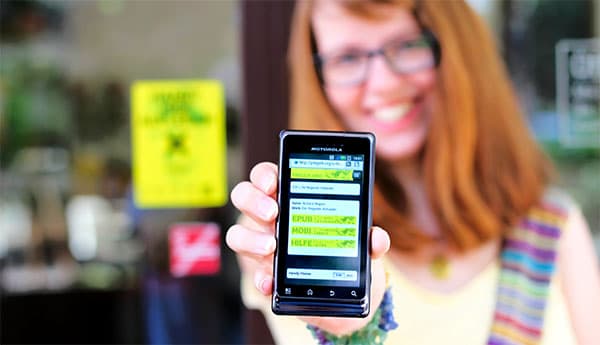NFC can turn your city into a giant virtual library …
… and help artists get discovered more easily. In July 2012 a nonprofit culture project turned an Austrian town into a giant library. Today we are pleased to announce that the software is now available for free (CC 3.0 BY license) for anyone who wants to promote local artists or do other crazy stuff with NFC. The WordPress-plugin and documentation can be found at http://pep.pingeb.org.
Free press images: pingeb.org/presse | Download PDF-version of this text.

On November 3rd Georg Holzer announced the availability of the tools and documentation enabling the project during his talk at TEDx Vienna. These are now available free of charge to anyone who wants to use them. An easy-to-install WordPress-plugin manages URLs and refreshes content for NFC-tags and QR-codes on stickers and posters, making possible a wide range of time-dependent and location-based applications in public places. Here are just some of the things which can be done with NFC tools:
- You can promote artists with samples of their work, as we did with “Project Ingeborg”.
- You can distribute e-books or songs that are out of copyright or to which you have rights.
- You can surprise people with a daily YouTube video or a song from Soundcloud.
- You can post a photo-of-the-day which people can access with their smartphones.
- You can offer a daily insider tip for restaurants or bars around town.
- You can introduce developers and their apps and offer links to their pages in app stores.
- You can promote your own blog or website around town and do all kinds of advertising for just about anything.
- Stadiums, museums or exhibitions can locate visitors and give (indoor) location-based information.
In other words, you can do a lot in public places with this WordPress-plugin and simple NFC-tags or QR-codes. Without having to change the stickers or posters you can even provide fresh content every day either at all or at selected locations.
“We tried to hide the complexity from the end user as much as possible”, says Bruno Hautzen-berger, co-founder, who wrote the code for the project. This is how it all works for the end user:
- Switch on your NFC-enabled smartphone and hold it against a sticker or photograph with the QR-code.
- A mobile website featuring the content will then be opened.
- The song or e-book on offer is then just one tap away.
For many people in Klagenfurt this has been their first contact with NFC and hopefully this will be happening soon in other places too. Unfortunately there usually isn’t a lot you can do with an NFC-capable smartphone once you leave the store. But Holzer and Hautzenberger wanted NFC to do more, much more. And so Project Ingeborg was born. A project which can turn a whole city into a virtual library.
The project takes its name from Klagenfurt-born post-war writer Ingeborg Bachmann, one of the most distinguished German-language authors. The launch of our project at the beginning of July coincided with the famous annual Bachmann literature festival and so guaranteed us a lot of atten-tion.
And the great thing is –the whole set-up is cheap to implement. The cost of realizing a project like this in a city as big as Vienna or Berlin would be less than 1,000 euros (1,300 USdollars) a year.
Plugin-features
The pingeb.org-Plugin works in conjunction with the “Maps Marker” plugin, which is also available for free. Both extend the functionality of WordPress and are very easy to use. The workflow sequence is as follows:
- Add locations
- Assign URLs to the locations
- Assign content to each location either individually or in a batch
The plugin generates random URLs for NFC-tags and QR-codes that connect to the content. This makes the content accessible exclusively via mobile devices. Accessed in a conventional way, pingeb.org would be no more than one of many websites, but because action on the part of the user is necessary, this raises the regard for the free piece of art featured and increases the fun of discovering new artists. If you want to, URLs can also be made more “speaking” and obvious. QR-codes generated within the plugin can be copied easily to any layout program for stickers or post-ers. Because the plugin supports geofence, it is not even necessary to use stickers or posters.
Changing the content (pages in WordPress) for the mobile locations is done with just two mouse clicks.
One option allows you to send a tweet anytime a user discovers a new artist or downloads content from a mobile website.
A maintenance section helps you identify stickers that have been inactive for a while and that may even have been removed.
Via shortcodes you can easily set up a statistics page that shows, for example, the NFC- vs. QR-ratio or the latest downloads on a heatmap. A counter on your site allows you to display today’s down-loads total and the overall number of downloads.
A forthcoming update will allow the plugin to phone home (via a counter on pingeb.org) with information about how many installations are online and in which cities artists can be discovered using this app. However, for privacy reasons project owners will be able to turn off this feature.
A tiny RESTful API gives users like you and third-party developers a few tools to build with.
The “Maps Marker”-plugin enables you to automatically generate a map with all your locations on your site. It also permits you to use the locations in an augmented reality app like Wikitude.
Creative Commons 3.0 BY
The project was initiated by journalist Georg Holzer and software engineer Bruno Hautzenberger, who simply wanted to play around with technology. It evolved from 70 stickers linking with classic e-books into a powerful tool that can be used for showcasing new artists. “At the start we did not know where it would all head. We only knew that there was potential here for something really big, maybe something of global dimensions”, says Holzer.
The license chosen is very liberal and should give anyone interested an opportunity to use the technology free of charge and even to play with the code. “Improve it, fork it or build upon it! With the help of others it can get even better than it is now”, says Hautzenberger. Both the documenta-tion and the code are stored in a repository on github.com that can be found at pep.pingeb.org.
By the way: PEP stands for “pingeb.org every place”. “There is no reason why people in New York, Berlin, Cape Town or Shanghai shouldn’t use this plugin”, Holzer said on stage at TEDx Vienna.
At the end of September 2012 Project Ingeborg was a finalist in an Austria-wide competition (netidee.at) and won a grant of 10,000 euros from the Austrian Internet Foundation (IPA). This covered the cost of the initial project, allowed the developers to package everything for re-use, and provided them with the opportunity to market the project to prospective enthusiasts around the world.
project team
Georg Holzer, journalist and author
Bruno Hautzenberger, software engineer
With great support from our friends: Kerstin Rosenzopf (artwork), Verena Artinger (webdesign), Iris Wedenig (literature), Martina Brücker and Nadja Rosenzopf (models for press photographs), and Daniel Gollner (video).
Press contact:
web: pingeb.org
phone: +43-463-930330
e-mail: mail@pingeb.org




Trackbacks & Pingbacks
[…] It’s a WordPress plug in. For more information see the English press release at PINGEB.org […]
Hinterlasse einen Kommentar
An der Diskussion beteiligen?Hinterlasse uns deinen Kommentar!